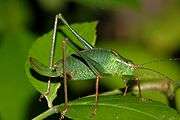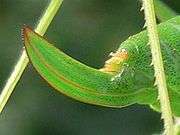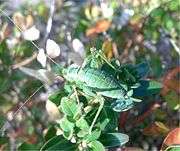Speckled bush-cricket
|
Sound of Leptophyes punctatissima
Field recording in the Netherlands 27s
|
| Problems playing this file? See media help. |
The speckled bush-cricket (Leptophyes punctatissima) is a flightless species of bush-cricket that occurs across most of Europe.
Description
The grass-green body, which is about 15 millimetres (0.59 in) long, carries minute black specks, as reflected in the common and Latin name of the species; in addition, the dorsal surface of the abdomen features a brown stripe; this is more pronounced in the male.[1][2] A yellow-white stripe extends backwards from the eyes.[3] The lower legs and feet are brownish.[2] The antennae are twice as long as the body.[1] The species is brachypterous: the male's forewings are reduced to small flaps, and those of the female are even more reduced.[1][2] The hindwings are completely absent, and both males and females are flightless.[1][2]
The female's ovipositor is laterally compressed and curves sharply upwards.[1][2] The song of the male, produced by rubbing the right wing against a tooth-like projection at the base of the left,[1] is short (1 to 10 ms) and feeble; at a frequency of 40 kHz, it can best be heard with the aid of a bat detector. Unlike other cricket species, the female is able to respond to the male's calls with a weaker call of her own, which attracts the male to her.[1]
The speckled bush-cricket is quite a common species, but its colouring and secretive lifestyle, hidden away in the undergrowth, mean that it often passes unnoticed.[2]
Distribution
The speckled bush-cricket is common across much of Europe – it ranges from the British Isles, France and [Belgium] in the west to the European parts of Russia in the east, and from southern Scandinavia in the north to southern Italy, Bulgaria and Greece; it has been recorded as far south as Palestine.[3]
References
Gallery
Speckled bush-cricket
(Leptophyes punctatissima) |
|---|
| Speckled bush cricket nymph |
| Female with upwards-curving ovipositor |
| Close-up view of ovipositor |
| Male with rudimentary wings on top of his back |
| In the female, the wings are even more reduced |
| Southern England Bush Cricket |
|
_nymph_2.jpg)






